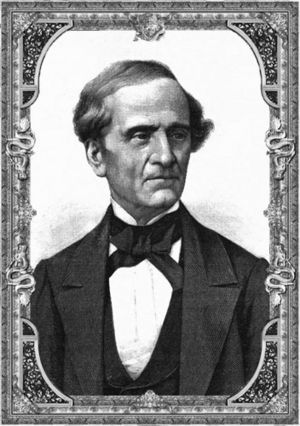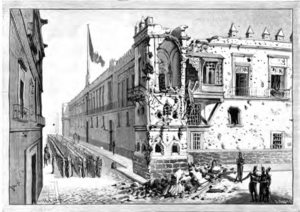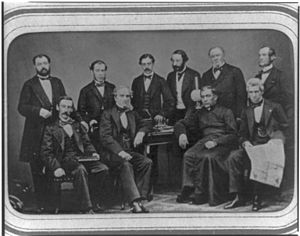José María Gutiérrez de Estrada facts for kids
Quick facts for kids
José María Gutiérrez de Estrada
|
|
|---|---|
 |
|
| Minister of Interior and Exterior Relations | |
| In office 23 January 1835 – 1 June 1835 |
|
| President | Antonio López de Santa Anna Miguel Barragán |
| Preceded by | Francisco María Lombardo |
| Succeeded by | José María Ortiz Monasterio |
| Personal details | |
| Born | 17 October 1800 San Francisco de Campeche, New Spain |
| Died | 17 May 1867 (aged 66) Paris, France |
| Political party | Conservative |
José María Gutiérrez de Estrada (born October 17, 1800 – died May 17, 1867) was an important Mexican diplomat, minister, and senator. He was known for being a conservative politician. This means he believed in keeping many traditional ways of government and society. He came from the state of Yucatan, where his brother, Joaquín Gutiérrez de Estrada, also became a governor.
Estrada was one of the most famous monarchists in Mexico. A monarchist is someone who believes a country should be ruled by a king or emperor, not a president. In 1840, he wrote an essay saying Mexico should have a monarchy. Many years later, in 1863, he led a group that offered the throne of Mexico to Maximilian of Habsburg at Miramare Castle.
Contents
Early Life and Political Start
José María Gutiérrez was born on October 17, 1800. His family was very rich in Yucatan, which allowed him to get a good education in Mexico City. When he was 28, President Guadalupe Victoria sent him on a special mission. He worked for the Ministry of Foreign Relations, which handles how Mexico deals with other countries. His job was to deliver important papers for a treaty between Mexico and Holland.
Around this time, he married the sister of José Justo Gómez de la Cortina. This marriage brought together two very rich and important families in Mexico.
In 1831, he was chosen to be a senator for Yucatan. Because he was part of the Conservative Party, he became an enemy of the Liberals in Congress. Liberals believed in more modern changes and less traditional government. In 1833, the liberal president Valentin Gomez Farias sent him and others into exile.
Estrada was also known for his writing. His friends and his wife's family helped him become famous for his literary skills. These connections also helped him become the Minister of Foreign Relations in 1835, under President Santa Anna. This was a very important job for him.
Foreign Minister Role
As Foreign Minister, Estrada wanted to make Mexico's relationships with European countries stronger. At that time, Mexico was only recognized by a few countries like the United States, Peru, England, Holland, France, Prussia, and the Holy See. He wanted to establish relations with Spain, which had not yet recognized Mexico's independence. He also tried to fix relationships with Central American countries. His time as foreign minister ended in July 1836.
After this, he traveled to Europe. While in Madrid, he was named the Mexican ambassador to Great Britain. His task was to stop Britain from recognizing Texas as independent and to oppose the United States taking over Texas. However, he could never officially start this job because Mexico's government was changing too quickly.
He returned to Mexico in 1840. He saw the Federalist Revolt of 1840, where rebels took President Anastasio Bustamante hostage. This crisis caused a week of fighting in the capital, many people left the city, and the National Palace was damaged.
His Monarchist Essay

After the revolt, President Bustamante escaped and won. He asked Estrada to be Foreign Minister again, but Estrada said no. Instead, in October 1840, Estrada published an essay. In this essay, he suggested that Mexico should hold a meeting to find ways to solve the country's problems. He openly said that the republic (a government with a president) had failed. He believed Mexicans should invite a European prince to become a king or emperor of Mexico. This, he thought, would bring stability.
He argued that there isn't one perfect type of government for all countries. He pointed out that even in France, liberals were having trouble setting up a republic. He also warned that the chaos in Mexico could lead to other countries getting involved. He worried that the United States might take over Mexico. He preferred to choose a foreign monarch who would care about Mexico's success.
The Mexican government called his essay an act of treason. Many people wrote against it. The person who published the essay was put in jail, and Estrada was sent away to Europe. Fanny Calderon, who knew Estrada, wrote about the strong reactions to his essay in her book Life in Mexico. Even though his idea was not popular at first, the Mexican-American War later showed that some of his warnings were true. This made him even more determined to push for a monarchy.
The Second Mexican Empire
In 1853, there was a change in government. The conservative politician Lucas Alamán invited Santa Anna to be president. The plan was for Santa Anna to rule only until a foreign monarch could be found. The government contacted José María Gutiérrez Estrada and asked him to officially look for a royal candidate in Britain, France, Austria-Hungary, and Spain. Estrada suggested that another monarchist, Jose Maria Hidalgo, should also look for a Spanish candidate.
Lucas Alamán died in 1853. In 1855, a liberal group took over the government from Santa Anna. Estrada and Hidalgo lost their official government support. This stopped the official search for a monarchy in Mexico.
However, Estrada and Hidalgo kept working to establish a Mexican monarchy, even without government support. Gutierrez met with Napoleon III, the Emperor of France, in 1857. Hidalgo later got another official job with the Mexican government, but he had no orders to work on a monarchy project. Hidalgo made an important connection with Eugénie de Montijo, the wife of Napoleon III. In 1857, she became very excited about the idea of a Mexican monarchy and started to talk to her husband about it. Estrada and Hidalgo continued to try to convince Napoleon III. But in 1857, Napoleon said he had no reason to get involved and did not want to upset the United States.
In July 1861, Mexico faced money problems and stopped paying its foreign debts. France, Spain, and Great Britain agreed to send soldiers to Mexico, but only to get their money back. However, the United States was busy with its own Civil War. This gave Napoleon III a chance to carry out the plans that Estrada and Hidalgo had suggested. French soldiers landed in Mexico in December 1861. Spain and Great Britain left when they realized France had other plans beyond just collecting debts. The French invasion of Mexico began in April 1862.
Conservative Mexican generals, who had not been fully defeated in the War of Reform, joined the French. After a small French force was defeated at the Battle of Puebla, more soldiers were sent. The capital, Mexico City, was taken by June 1863. The French then wanted to set up a friendly Mexican government. They chose a committee of 35 Mexicans, who then picked three leaders: Juan Nepomuceno Almonte, José Mariano Salas, and Pelagio Antonio de Labastida. These three leaders then chose 215 more Mexicans to form an "Assembly of Notables."
The Assembly met in July 1863 and decided to invite Ferdinand Maximilian to be the Emperor of Mexico. The three leaders became the "Regency of the Mexican Empire." An official group left Mexico and arrived in Europe in October. Estrada joined them and became the formal head of this group. Maximilian said he would only accept the throne if the Mexican people voted for it. By February 1864, French and Mexican forces controlled most of Mexico's population. Votes were sent to Maximilian, claiming that most Mexicans wanted the Empire. He accepted. Maximilian officially became Emperor on April 10, 1864, and sailed to Mexico. Estrada stayed in Europe as Maximilian's representative.
Maximilian wanted to make good changes, and he did gain some Mexican supporters. However, his government was helped by foreign armies, so it lacked true support from many Mexicans. It was always fighting against those who supported the Mexican republic. The United States never recognized the Empire. After their Civil War ended, the U.S. pressured France to leave Mexico. France agreed and began to leave in 1866. The Empire lasted a few more months as Maximilian and his Mexican supporters fought their last battles against the Republicans. They were defeated, and Maximilian and his two main Mexican generals were put on trial and executed on June 19, 1867. Estrada had died almost exactly one month earlier, on May 17, in Paris.
See also
 In Spanish: José María Gutiérrez de Estrada para niños
In Spanish: José María Gutiérrez de Estrada para niños


